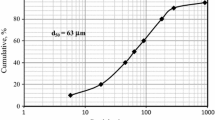Abstract
Conventional tailings slurry contains a significant amount of water, and water management is key to ensuring the stability of a tailings storage facility (TSF). Simply reducing the water content in the slurry before discharging it from the mill could be an effective way to improve TSF water management. This study investigated the potential for using an environmentally friendly polymer as a new drag reduction agent (DRA) to reduce frictional pressure loss and also conserve water. It entailed conducting pipe loop tests to assess the polymer’s effect on pressure loss in tailings flow and then applying the test results to validate a numerical model using computational fluid dynamics (CFD). The model was also used to determine the polymer’s optimal concentrations at given solid concentrations and flow rates, its effect on energy efficiency for tailings transportation, and its potential for saving water. A case study for a mid-sized, hard-rock mine with a throughput of 50,000 t/day found that the solid concentration could be increased from 30 to 45% with no pressure loss by applying 1996 m3 of the polymer per day. Adding the polymer also resulted in water savings of 57,552 m3/day. The results of this study demonstrated the potential for using the new DRA not only to improve TSF stability but also to save water.










Similar content being viewed by others
References
Lottermoser B (2007) Mine wastes: characterization, treatment and environmental impacts, 2nd edn. Springer, Berlin
Vick SG (1990) Planning, design, and analysis of tailings dams. Wiley, New York
Jewell R, Fourie A (2006) Paste and thickened tailings: a guide. The University of Western Australia, Australian Centre for Geomechanics
Rico M, Benito G, Salgueiro A, Diez-Herrero A, Pereira H (2008) Reported tailings dam failures: a review of the European incidents in the worldwide context. J Hazard Mater 152(2):846–852
Burritt RL, Christ KL (2018) Water risk in mining: analysis of the Samarco dam failure. J Clean Prod 178:196–205
Zandarin MT, Oldecop LA, Rodriguez R, Zabala F (2009) The role of capillary water in the stability of tailing dams. Eng Geol 105(1–2):355 108–118
Abulnaga BE (2002) Slurry systems handbook. McGraw-Hill, New York
Watson A, Corser P, Garces Pardo E, Lopez Christian T, Vandekeybus J A comparison of alternative tailings disposal methods-the promises and realities. Proceedings from Mine Waste, Perth
Heywood N (1986) A review of techniques for reducing energy consumption in slurry pipelines, Proc. Hydrotransport 10, BHRA Fluid Engineering Cranfield, Bedford, England. 1986:319–331
Horsley R (1982) Viscometer and pipe loop tests on gold slime slurry at very high concentrations by weight, with and without additives. Proc Hydrotransport 8
Kolar V (1970) Visco-elastic fluid solid flow in pipes, in. Proc Hydrotransport 1
Verma AK (2004) Study on high concentration y ash slurry disposal through pipeline, Ph.D. thesis
Al-Sarkhi A (2010) Drag reduction with polymers in gas-liquid/liquid-liquid flows in pipes: a literature review. J Nat Gas Sci Eng 2(1):41–48
Warholic M, Massah H, Hanratty T (1999) Influence of drag-reducing polymers on turbulence: effects of Reynolds number, concentration and mixing. Exp Fluids 27(5):461–472
Wilson KC, Addie GR, Sellgren A, Clift R (2006) Slurry transport using centrifugal pumps. Springer Science & Business Media
Cooke R (2007) Thickened and paste tailings pipeline systems: design procedure-part 2. International Seminar on Paste and Thickened Tailings, Perth
Abdulbari HA, Shabirin A, Abdurrahman H (2014) Bio-polymers for improving liquid flow in pipelines-a review and future work opportunities. J Ind Eng Chem 20(4):1157–1170
Webster R, Elliott V, Park BK, Walker D, Hankin M, Taupin P (2009) Peg and peg conjugates toxicity: towards an understanding of the toxicity of peg and its relevance to pegylated biologicals. In: PEGylated protein drugs: Basic science and clinical applications. Springer, pp 127–146
Kudela H. Hydraulic losses in pipes, Wroclas University of Science and
Boger D, Scales P, Sofra F (2006) Rheological concepts, paste and thickened tailings-a guide. 25–37
Ansys I Ansys fluent user’s guide, Canonsburg, PA
Wilcox DC et al (1998) Turbulence modeling for CFD, vol 2. DCW industries La Canada, CA
Rolander N, Rambo J, Joshi Y, Allen JK, Mistree F (2006) An approach to robust design of turbulent convective systems. J Mech Des 128(4):844–855
Hashemi S, Wilson K, Sanders R (2014) Specific energy consumption and optimum operating condition for coarse-particle slurries. Powder Technol 262:183–187
Paterson A (2004) High density slurry and paste tailings, transport systems. in: International Platinum Conference Platinum Adding Value, pp. 159–166
Liu H, Yang W, Kang R (2018) A correlation for sand erosion prediction in annular flow considering the effect of liquid dynamic viscosity. Wear 404:1–11
Author information
Authors and Affiliations
Corresponding author
Ethics declarations
Conflict of Interest
The authors declare that they have no conflict of interest.
Additional information
Publisher’s Note
Springer Nature remains neutral with regard to jurisdictional claims in published maps and institutional affiliations.
Rights and permissions
About this article
Cite this article
Jeong, Y., Kim, K. Use of an Environmentally Friendly Polymer to Reduce the Water Content in Tailings Slurry. Mining, Metallurgy & Exploration 37, 1475–1486 (2020). https://doi.org/10.1007/s42461-020-00253-2
Received:
Accepted:
Published:
Issue Date:
DOI: https://doi.org/10.1007/s42461-020-00253-2




